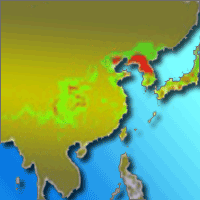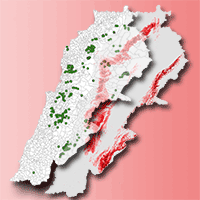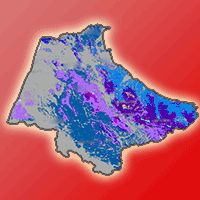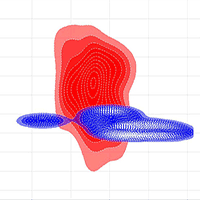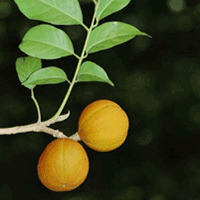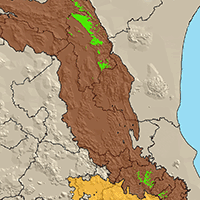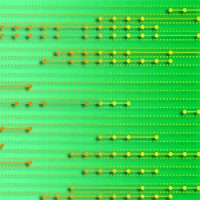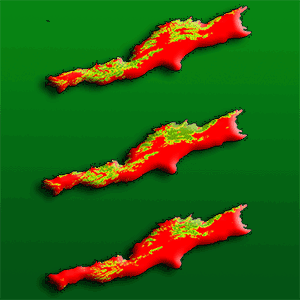A better understanding of the distribution of suitable habitats of Larix kaempferi and its environmental constraints is crucial to know how global climate change will affect its growth and future dynamics. We simulated global suitable distribution areas of L. kaempferi under current and future climates, using different representative concentration pathway (RCP) scenarios, to evaluate the main factors affecting its geographical distribution. The results showed that under current climate conditions the suitable distribution areas of L. kaempferi are concentrated in Europe and Asia, followed by North America. The “Germany-Sweden-Britain” (19.42% of the total worldwide area) and “China-Japan-North Korea” (43.11%) regions are the cores for L. kaempferi distribution. The suitable distribution area for L. kaempferi is large in China (33.75% of the total area). The suitable distribution areas in Asia, Europe, and China decreased and shifted northward in the RCP scenarios. The main climatic factors affecting the distribution of L. kaempferi were the annual mean temperature, mean temperature of the coldest quarter, annual mean precipitation, and precipitation in the driest month. L. kaempferi could adapt or move to higher latitudes/altitudes to cope with climate change. Our results contribute to the introduction, cultivation, and management of L. kaempferi and potentially of other deciduous gymnosperms.
Keywords
, , , ,
Citation
Wu C, Shen J, Chen D, Du C, Sun X, Zhang S (2020). Estimating the distribution characters of Larix kaempferi in response to climate change. iForest 13: 499-506. - doi: 10.3832/ifor3570-013
Academic Editor
Maurizio Marchi
Paper history
Received: Jul 05, 2020
Accepted: Aug 18, 2020
First online: Nov 01, 2020
Publication Date: Dec 31, 2020
Publication Time: 2.50 months
© SISEF - The Italian Society of Silviculture and Forest Ecology 2020
Open Access
This article is distributed under the terms of the Creative Commons Attribution-Non Commercial 4.0 International (https://creativecommons.org/licenses/by-nc/4.0/), which permits unrestricted use, distribution, and reproduction in any medium, provided you give appropriate credit to the original author(s) and the source, provide a link to the Creative Commons license, and indicate if changes were made.

Breakdown by View Type
(Waiting for server response...)
Article Usage
Total Article Views: 38151
(from publication date up to now)
Breakdown by View Type
HTML Page Views: 32623
Abstract Page Views: 2340
PDF Downloads: 2549
Citation/Reference Downloads: 7
XML Downloads: 632
Web Metrics
Days since publication: 1876
Overall contacts: 38151
Avg. contacts per week: 142.35
Article Citations
Article citations are based on data periodically collected from the Clarivate Web of Science web site
(last update: Mar 2025)
Total number of cites (since 2020): 1
Average cites per year: 0.17
Publication Metrics
by Dimensions ©
Articles citing this article
List of the papers citing this article based on CrossRef Cited-by.
(1)
Alexander HD, Natali SM, Loranty MM, Ludwig SM, Spektor VV, Sergey D, Zimov N, Trujillo I, Mack MC (2018)Impacts of increased soil burn severity on larch forest regeneration on permafrost soils of far northeastern Siberia. Forest Ecology and Management 417: 144-153.
CrossRef |
Gscholar
(2)
Bai XP, Zhang XL, Li JX, Duan XY, Jin YT, Chen ZJ (2019)Altitudinal disparity in growth of Dahurian larch (
Larix gmelinii Rupr.) in response to recent climate change in northeast China. Science of The Total Environment 670: 466-477.
CrossRef |
Gscholar
(3)
Cáceres CB, Hernández RE, Fortin Y (2017)Shrinkage variation in Japanese larch (
Larix kaempferi [Lamb.] Carr.) progenies / provenances trials in Eastern Canada. Wood Material Science and Engineering 13 (2): 1-7.
CrossRef |
Gscholar
(4)
Chen DS, Sun XM, Zhang SG (2016)Biomass, carbon storage and nutrient characteristics in
Larix kaempferi plantations at different stand ages. Chinese Journal of Applied Ecology 27 (12): 3759-3768. [In Chinese]
Online |
Gscholar
(5)
Chen FQ, Song NN, Chen GH, Wang JZ (2015)Effects of exotic species
Larix kaempferi on diversity and activity of soil microorganisms in Dalaoling National Forest Park. Ecological Processes 4 (1): 612.
CrossRef |
Gscholar
(6)
Chen XM, Lei YC, Zhang XQ, Jia HY (2012)Effects of sample sizes on accuracy and stability of maximum entropy model in predicting species distribution. Scientia Silvae Sinicae 48 (1): 53-59. [In Chinese]
Online |
Gscholar
(7)
Dyderski MK, Paz S, Frelich LE, Jagodzinski AM (2018)How much does climate change threaten European forest tree species distributions? Global Change Biology 24: 1150-1163.
CrossRef |
Gscholar
(8)
Fukatsu E, Nakada R (2018)The timing of latewood formation determines the genetic variation of wood density in
Larix kaempferi. Trees 32 (5): 1233-1245.
CrossRef |
Gscholar
(9)
Hastie T, Tibshirani R (1990)Generalized additive models. Monographs on “Statistics and Applied Probability” (vol. 1), Chapman and Hall, London, UK, pp. 590-606.
Gscholar
(10)
Hijmans RJ, Cameron SE, Parra JL, Jones PG, Jarvis A (2005)Very high resolution interpolated climate surfaces for global land areas. International Journal of Climatology 25 (15): 1965-1978.
CrossRef |
Gscholar
(11)
Hoshi H (2004)Forest tree genetic resources conservation stands of Japanese larch (
Larix kaempferi (Lamb.) Carr.). Forest Tree Genetic Resources Information 1 (1): 1-4.
Online |
Gscholar
(12)
Huang KF, Zhu WM, He MS (1996)Regional research on introduction of
Larix kaempferi. Sichuan Forest Exploration Design 3: 21-25. [In Chinese]
Gscholar
(13)
Huang WW (2017)Climate responses in growth and wood anatomy of important forest tree species in Denmark. Department of Geosciences and Natural Resource Management, Faculty of Science, University of Copenhagen, Denmark, pp. 22.
Online |
Gscholar
(14)
Kotani A, Saito A, Kononov AV, Petrov RE, Maximov TC, Iijima Y, Ohta T (2019)Impact of unusually wet permafrost soil on understory vegetation and CO
2 exchange in a larch forest in eastern Siberia. Agricultural and Forest Meteorology 265: 295-309.
CrossRef |
Gscholar
(15)
Li GQ, Liu CC, Liu YG, Yang J, Zhang XS, Guo K (2013)Advances in theoretical issues of species distribution models. Acta Ecologica Sinica 33 (16): 4827-4835. [In Chinese]
CrossRef |
Gscholar
(16)
Li Y, Zou D, Ren B, Ding X, Bian H, Wang J (2016)Balancing effect of larch plantations (
Larix kaempferi) on understory plant diversity in a subtropical forest ecosystem, China. Applied Ecology and Environmental Research 14 (3): 397-407.
CrossRef |
Gscholar
(17)
Lu YH, Coops NC, Wang TL, Wang GY (2015)A process-based approach to estimate Chinese fir (
Cunninghamia lanceolata) distribution and productivity in southern China under climate change. Forests 6: 360-379.
CrossRef |
Gscholar
(18)
Ma CG (1992)On the countermeasures for the improvement of larch in China from the
status quo of genetic improvement of larch in the world. World Forestry Research 1: 57-65. [In Chinese]
Gscholar
(19)
Mamet SD, Brown CD, Trant AJ, Laroque CP (2019)Shifting global
Larix distributions: northern expansion and southern retraction as species respond to changing climate. Journal of Biogeography 46: 30-44.
CrossRef |
Gscholar
(20)
Mateo RG, Felicísimo AM, Muñoz J (2011)Species distributions models: a synthetic revision. Revista Chilena de Historia Natural 84 (2): 217-240.
CrossRef |
Gscholar
(21)
Nagaike T, Hayashi A, Abe M, Arai N (2003)Differences in plant species diversity in
Larix kaempferi plantations of different ages in central Japan. Forest Ecology and Management 183 (1-3): 177-193.
CrossRef |
Gscholar
(22)
Nakada R, Fukatsu E (2012)Seasonal variation of heartwood formation in
Larix kaempferi. Tree Physiology 32 (12): 1497-1508.
CrossRef |
Gscholar
(23)
Obojes N, Meurer A, Newesely C, Tasser E, Oberhuber W, Mayr S, Tappeiner U (2018)Water stress limits transpiration and growth of European larch up to the lower subalpine belt in an inner-alpine dry valley. New Phytologist 220 (2): 460-475.
CrossRef |
Gscholar
(24)
Padalia H, Srivastava V, Kushwaha SPS (2014)Modeling potential invasion range of alien invasive species,
Hyptis suaveolens (L.) Poit. in India: comparison of MaxEnt and GARP. Ecological Informatics 22: 36-43.
CrossRef |
Gscholar
(25)
Pâque LE (2002)Improvement of larch (
Larix sp.) for better growth, stem form and wood quality. In: Proceedings of the Meeting “LARIX-2002” (Pâque LE ed). Gap (France) 16-21 Sept 2002. INRA, Orleans, France, pp. 19-21.
Gscholar
(26)
Peng K, Peng J, Huo J, Yang L (2018)Assessing the adaptability of alien (
Larix kaempferi) and native (
Pinus armandii) tree species at the Baiyunshan Mountain, central China. Ecological Indicators 95: 108-116.
CrossRef |
Gscholar
(27)
Phillips SJ, Anderson RP, Schapire RE (2006)Maximum entropy modeling of species geographic distribution. Ecological Modelling 190: 231-259.
CrossRef |
Gscholar
(28)
Rehfeldt GE, Jaquish BC (2010)Ecological impacts and management strategies for western larch in the face of climate-change. Mitigation and Adaptation Strategies for Global Change 15: 283-306.
CrossRef |
Gscholar
(29)
Romo H, Sanabria P, Garcíabarros E (2013)Predicting climate change impacts on Lepidoptera species distribution. The case of genus
Boloria Moore, 1900 in the Iberian Peninsula (Lepidoptera: Nymphalidae). Shilap-Revista de Lepidopterologia 41 (162): 267-286.
Gscholar
(30)
Saulnier M, Corona C, Stoffel M, Guibal F, Edouard JL (2019)Climate-growth relationships in a
Larix decidua Mill. network in the French Alps. Science of the Total Environment 664: 554-566.
CrossRef |
Gscholar
(31)
Shao XW (1985)Study on the ecological survey of
Larix kaempferi. Journal of Shandong Forestry Science and Technology 1: 9-18. [in Chinese]
Gscholar
(32)
Stocker TF, Qin D, Plattner GK, Tignor M, Allen SK, Boschung J, Nauels A, Xia Y, Bex V, Midgley PM (2013)Climate Change 2013: the physical science basis. Contribution of Working Group I to the Fifth Assessment Report of the Intergovernmental Panel on Climate Change. Computational Geometry 18 (2): 95-123.
Gscholar
(33)
Swets JA (1988)Measuring the accuracy of diagnostic systems. Science 240 (4857): 1285-1293.
CrossRef |
Gscholar
(34)
Tchebakova NM, Rehfeldt GE, Parfenova EI (2005)Impacts of climate change on the distribution of
Larix spp. and
Pinus sylvestris and their climatypes in Siberia. Mitigation and Adaptation Strategies for Global Change 11: 861-882.
Gscholar
(35)
Wang JZ, Ding ZF, Zeng FS (2008)The breeding of
Larix kaempferi. Liaoning University Press, Shenyang, Liaoning, pp. 24-26. [in Chinese]
Gscholar
(36)
Wang T (2012)Projecting future distributions of ecosystem climate niches in British Columbia. Journal of Ecosystems and Management 13 (2): 1-3.
Online |
Gscholar
(37)
Wang TL, Wang GY, Innes J, Nitschke C, Kang HJ (2016)Climatic niche models and their consensus projections for future climates for four major forest tree species in the Asia-Pacific region. Forest Ecology and Management 360: 357-366.
CrossRef |
Gscholar
(38)
Wiley EO, Mcnyset KM, Peterson AT, Robins CR, Stewart AM (2003)Niche modeling and geographic range predictions in the marine environment using a machine-learning algorithm. Oceanography 16 (3): 120-127.
CrossRef |
Gscholar
(39)
Williams GM, Nelson AS (2018)Spatial variation in specific leaf area and horizontal distribution of leaf area in juvenile western larch (
Larix occidentalis Nutt.). Trees - Structure and Functions 32: 1621-1631.
CrossRef |
Gscholar
(40)
Wu XY, Dong SK, Liu SL, Su XK, Han YH, Shi JB, Zhang Y, Zhao ZZ, Sha W, Zhang X, Gao F, Xu DH (2017)Predicting the shift of threatened ungulates’ habitats with climate change in Altun Mountain National Nature Reserve of the Northwestern Qinghai-Tibetan Plateau. Climatic Change 142 (3-4): 331-344.
CrossRef |
Gscholar
(41)
Yao LI, Zhang XW, Fang YM (2016)Responses of the distribution pattern of
Quercus chenii to climate change following the Last Glacial Maximum. Chinese Journal of Plant Ecology 40 (11): 1164-1178. [in Chinese]
CrossRef |
Gscholar
(42)
Yoshida T, Hasegawa M, Taira H, Noguchi M (2005)Stand structure and composition of a 60-year-old larch (
Larix kaempferi) plantation with retained hardwoods. Journal of Forest Research 10: 351-358.
CrossRef |
Gscholar
(43)
Zhang L, Liu S, Sun P, Wang T, Wang GY, Zhang XD, Wang LL (2015)Consensus forecasting of species distributions: the effects of niche model performance and niche properties. PLoS One 10 (3): e0120056.
CrossRef |
Gscholar
(44)
Zhang XQ, Wang Z, Chhin S, Wang HC, Duan AG, Zhang JG (2020)Relative contributions of competition, stand structure, age, and climate factors to tree mortality of Chinese fir plantations: Long-term spacing trials in southern China. Forest Ecology and Management 465: 118-103.
CrossRef |
Gscholar
